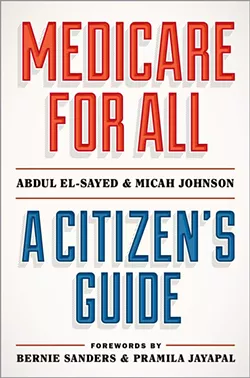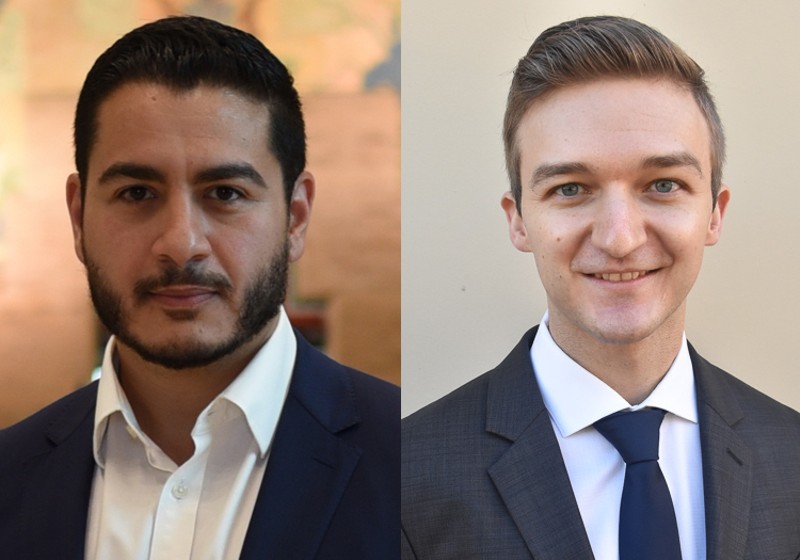
Senator Bernie Sanders made reforming America’s healthcare system a central pillar of his 2020 campaign for president, rallying for a proposal to provide Medicare for All. By the time he suspended his campaign in April, the need for major healthcare reform was ever more apparent as the coronavirus pandemic gripped the nation and the world.
We all know what happened next.
“During the greatest pandemic in modern American history, Americans suffered worse than our counterparts in other industrialized countries because we are the only ones who do not guarantee healthcare to every person as a human right,” Sanders writes in the foreword to Medicare for All: A Citizen’s Guide, out now from Oxford University Press.
The book was written by Dr. Abdul El-Sayed, a physician, epidemiologist, public health expert, and progressive activist who served as Detroit’s health director and ran for governor in 2018, and Micah Johnson, a resident physician in internal medicine at Brigham and Women’s Hospital in Boston, Massachusetts. An abridged excerpt is republished here with permission. —Lee DeVito
Lisa Cardillo will never forget her fifteenth wedding anniversary. After waving goodbye to their three children, Lisa and her husband, Dominic, drove across the state to Grandville, a few miles from Lake Michigan. They had more than their anniversary to celebrate: Dominic, who'd suffered a malignant brain tumor at just 33 years old, was three years past his cancer diagnosis. After a full year of treatment, including radiation, surgery, and chemotherapy, he was now down to a few MRIs a year to make sure that the cancer hadn't recurred. Eager for a fresh start, the Cardillos were excited for a weekend getaway filled with romantic sunsets, a brewery tour, and a Red Hot Chili Peppers concert.
But just as they were about to enjoy the day on Lake Michigan's sandy beaches, Lisa felt a sharp burning in the center of her chest. Then came the crippling nausea and abdominal pain. She'd read something on Facebook about a friend of a friend having similar symptoms a while back — a recollection that came rushing on now. Though Lisa was 36 years old and otherwise healthy, she knew that something was terribly wrong.
The Cardillos knew better than to call an ambulance — Dominic's had cost them $800 when he was first diagnosed. They rushed to the car and started Googling nearby hospitals. The nearest one was just twelve minutes away. Dominic stepped on the gas. Lisa's left arm started to go numb.
As Lisa walked into the emergency room, she went into cardiac arrest. With her heart no longer pumping blood, she crashed to the floor. The emergency room personnel started performing CPR then and there.
Over the next nine agonizing days at that hospital, Lisa was diagnosed with a heart attack caused by spontaneous coronary artery dissection — a deadly tearing of one of the arteries that supply blood to the heart. Though extremely rare, this condition has a predilection for young women, like Lisa. After her cardiac arrest, she went into heart failure. The doctors put Lisa in a medically induced coma and implanted a heart pump that would do the work that Lisa's ailing heart could not.
Thankfully, Lisa survived. But those nine days were only the beginning of her ordeal. She was discharged on a cocktail of cardiac drugs — some to manage the strain on her heart, some to reduce her blood pressure. For five months, she had to wear a defibrillator vest.
All of this was extremely expensive. The hospital sent a bill for $185,460. The defibrillator vest was another $5,000 a month. Then more bills for cardiac rehab, follow-up appointments, and prescriptions.
Lisa was no stranger to medical costs. She'd learned more than she ever wanted to know about navigating insurance bureaucracies dealing with Dominic's treatment just a few years earlier. His twice-annual MRIs cost thousands of dollars, on top of the cost of his radiation, chemotherapy, and surgical treatment.
And the Cardillos have insurance. Unlike the 30 million Americans who don't have it, they have health coverage through Dominic's job as an automotive engineer. Before Dominic's diagnosis, they had tried to save on premium costs by choosing an insurance plan with a high deductible, meaning they would need to spend more before insurance kicked in. That left them with $12,000 in uncovered medical bills for his care, which they were supposed to pay out of pocket. Owing ten different medical creditors money they didn't have, they quickly found themselves underwater. Though Lisa and Dominic resisted asking for help, their friends eventually started a GoFundMe page and threw an in-person fundraiser to partially allay their debts. Together, their friends and family raised nearly $8,000 — just enough to get them back on solid footing. But when Jan. 1 rolled around, their deductible reset and they found themselves back at square one paying for Dominic's ongoing treatment.
Beyond the financial toll, there was the personal toll. Lisa had spent hours on the phone with the various hospitals, clinics, labs, and imaging centers where they owed money — not to mention pleading with their insurance company to cover the costs of this or that treatment. More than once, she'd found herself crying to the faceless insurance bureaucrat on the other end of the line. "When your medical bills become more stressful than your husband's brain cancer diagnosis, something is not right," she told us.
After Dominic's diagnosis, they upgraded to a more expensive insurance plan: now their out-of-pocket costs were supposed to be capped at $7,000 per year. But there were also the unexpected costs they had thought their insurance would pay that it didn't. When Lisa had her defibrillator placed, for example, the insurance company said her anesthesiologist was out-of-network, meaning she'd have to pay an extra $1,500 out of pocket. Still recovering from her cardiac arrest, she was too tired to deal with it all. She tried to ignore the bills and convalesce before starting another round of fighting, cajoling, and even begging her insurers and creditors.
Medical calamity has forced the Cardillos to make decisions that they never imagined having to make. "Are we going to be able to take our kids on a vacation or are we going to pay these medical bills so they don't send us to collections? It's a balancing act, and it's something I never expected," Lisa said. They are constantly juggling their finances to meet the minimum payments for each of the creditors they've accumulated through their brushes with death.
Morbidly, Lisa jokes that her "favorite bill" is the one for "cardiopulmonary resuscitation" — the manual CPR she got in the emergency room. For $568, the hospital personnel saved her life. But because she hadn't met her deductible, she paid for it out of pocket. "It's the best $568 I ever spent," she said. But should she have had to spend it at all?
Lisa's heart condition is rare. But her experience with our healthcare system is not. Here's the truth: America is exceptional on virtually every healthcare measure. But more often than not, we're exceptional in exactly the wrong ways.
In a comprehensive study of the healthcare systems of eleven high-income countries, here's how America fared compared to our peer countries — places like Canada, Switzerland, and the United Kingdom. We spend the most money on healthcare in the world — nearly twice as much per person than our peer countries on average. Our national healthcare bill in 2016 came to $9,400 per person, versus an average of $5,000 in our peer countries — and in 2021 we're projected to spend more than $12,000 per person. For every dollar spent in our economy, 18 cents go to healthcare. The average in our peer countries is below 11 cents.
What are we getting for this money? The short answer: worse health. This starts from the first moments of life. American infants have the highest rates of death. A baby's chance of death is twice as high if his mom is Black instead of white. American moms also die at the highest rates after giving birth. This discrepancy continues to the last moments of life: Americans die three years earlier than our peers abroad. It's no surprise we have the lowest satisfaction with our healthcare system among our peer countries — less than one in five Americans think our healthcare system works well.
America is the only advanced nation with a health insurance system that crumbled in the face of COVID-19. In the United States, millions lost their health insurance along with their jobs as a deadly contagion spread all around them.
tweet this
It gets worse. Even after the implementation of the Affordable Care Act (ACA), more than 30 million Americans still did not have health insurance in 2019. Our peer countries have uninsured rates between 0 percent and 0.2 percent. Ours is almost fifty times higher, at nearly 10 percent of the population. And Americans with insurance aren't getting the healthcare they need, either — more Americans report skipping medical care due to cost than in any other wealthy country. Those who do get the care they need are paying dearly for it. And if you're Black or poor, you're more likely to be on the wrong side of these statistics.
America is also the only advanced nation with a health insurance system that crumbled in the face of COVID-19. In most other countries, every single citizen kept their health coverage throughout the pandemic. In the United States, millions lost their health insurance along with their jobs as a deadly contagion spread all around them. Many Americans — insured or not — were forced to avoid care for fear of the costs. And our hospitals and clinics were brought to the brink of financial collapse when private insurance revenue dried up.
America's healthcare system is in critical condition. In this chapter, we'll try to get to the bottom of the diagnosis.
First, let's review the basic anatomy of American healthcare. When it comes to health insurance, we have no unified system to get people covered. Instead, Americans are carved up into half a dozen different systems. First is employer-based insurance: about half of Americans have private insurance coverage through their job, like Lisa and Dominic Cardillo. Second is Medicare, a public insurance program operated by the federal government that mostly covers Americans over age 65 (along with Americans who have certain disabilities). Third is Medicaid, a public insurance program operated by the states that mostly covers low-income Americans. Fourth is individual private insurance, usually purchased through the ACA marketplaces by people who do not have other options for insurance. Fifth are other public programs like the Veterans Health Administration and the Indian Health Service. Sixth and finally, some 30 million Americans remain uninsured. Based on their insurance, each of these groups has different access to a combination of basic and advanced healthcare services: primary care, emergency room visits, dental care, hospitalizations, prescription drugs, surgery, and more.
Combining all these parts of the U.S. healthcare system, in 2018 Americans spent a total of $3.6 trillion on healthcare. Nearly three-quarters of that money goes to four places: hospitals, doctors' offices, prescription drugs, and insurance administration. A third of all spending — over $1 trillion a year — goes to hospitals. Twenty percent goes to doctors' offices. Ten to 15 percent is spent on prescription drugs, and 8 percent goes to the overhead costs of the insurance system. The rest is spread across smaller categories like nursing homes, dental care, home healthcare, ambulances, and public health.
Our healthcare costs are increasing rapidly. In 2021, U.S. healthcare spending is expected to exceed $4 trillion. By 2025, it is projected to be over $5 trillion.
Though our healthcare system is complex, its problems are clear. Let's break them down.
PROBLEM #1: Our healthcare is too expensive
Our healthcare costs are almost double those in the rest of the world. Why is this?
Many people assume that our costs are higher simply because we use more healthcare. But that's not actually true. We go to the doctor less in America than people in nearly all of our peer countries — for comparison, Americans have an average of four physician visits per year, while Canadians have nearly eight. We also use hospitals less, in terms of both admissions and total days spent in the hospital.
If we don't use more healthcare than other countries, how are we spending twice as much? The first reason is that our prices are higher for just about everything in healthcare, including hospital stays, doctors' visits, and prescription drugs. The second reason is that we spend far more money on healthcare administration than other countries do. These two cost-drivers share an underlying cause: our insurance system, which both enables high prices and creates administrative complexity.
PROBLEM #2: Too many Americans can't access healthcare
Even though we dedicate nearly a fifth of our economy to healthcare, Americans are not receiving the care they need. More Americans lack access to healthcare than citizens in any other wealthy country.
Most severely, as of 2019 more than 30 million Americans had no health insurance at all. But even Americans with health insurance can face barriers that prevent them from accessing care. First, as detailed earlier, care is simply too expensive, even for people with insurance. Second, insurance often does not cover all the services Americans need. And finally, many Americans in low-income urban and rural communities simply don't have quality services available in their geographic area.
PROBLEM #3: Americans are sicker than we should be
Healthcare saves lives, so it should come as no surprise that access to it makes us healthier and lacking access makes us sicker. The clearest evidence on this point comes from studies showing that gaining health insurance prevents death. Numerous high-quality studies have found that Medicaid expansion has improved health and reduced mortality. A recent study also provided the first evidence from a randomized trial — the gold standard of scientific evidence — that health insurance prevents death. The Internal Revenue Service sent informational letters about health insurance options to millions of Americans who had previously paid a tax penalty for being uninsured under the ACA's individual mandate. Researchers found that Americans randomly chosen to receive the letter were more likely to have health insurance in subsequent years — and were less likely to die as a result. Estimates suggest that tens of thousands of Americans die every year due to lack of health insurance.
PROBLEM #4: The experience of giving and receiving healthcare is eroding
Virtually every American is (or will be) a patient of the healthcare system, and tens of millions of Americans are employed in healthcare. In our medical marketplace, patients and clinicians alike are getting left behind as our healthcare system becomes more complicated, more business-focused, and less personal.
That's the problem list we'll be focused on in this book. American healthcare is too expensive. Too many people can't get the care they need. We're sicker than we should be. And the experience of giving and receiving care is eroding.
Are these unrelated symptoms? Or are they common manifestations of the same underlying process?
There is a strong case to be made that America's unique healthcare problems stem from the unique structure of America's healthcare system, which is organized around a core principle: that healthcare should be treated as a consumer product.
Costs are high because healthcare does not have the fundamental characteristics of a market good, but we still buy and sell it in a marketplace — the resulting market failures keep prices high, and the marketplace itself imposes enormous administrative costs on the system. Poor and uneven access to care is an obvious consequence of treating healthcare as a consumer product: you receive as much care as you are willing and able to pay for, and the result is that millions go without needed care. We're sicker than our peers elsewhere in the world partly because our medical marketplace rations care according to income and fails to make investments that would keep us healthy over the long term. Our fragmented medical marketplace is also exhausting to navigate, eroding the experience of care for everyone involved.
To be sure, the American healthcare system contains some exceptions to the principle of treating healthcare as a consumer product. Every American is entitled to receive emergency care regardless of ability to pay — though they might receive an unaffordable bill in the mail after the fact. Seniors and some low-income Americans are guaranteed coverage from Medicare and Medicaid. But even these public programs have been injected with market features: most states have outsourced Medicaid to private insurance companies, and a third of Medicare beneficiaries are covered by private Medicare Advantage plans.
Most democracies have chosen to provide healthcare as a public good, available to all regardless of means. The United States generally provides healthcare as a market product, available to all who can afford it. But like the citizens of other democracies, many Americans over the last century have fought to make healthcare available to all. Why have we failed where others have succeeded?
Medicare for All: A Citizen's Guide is available now from Oxford University Press. You can order it from your local bookstore or bookshop.org.
Stay on top of Detroit news and views. Sign up for our weekly issue newsletter delivered each Wednesday.







